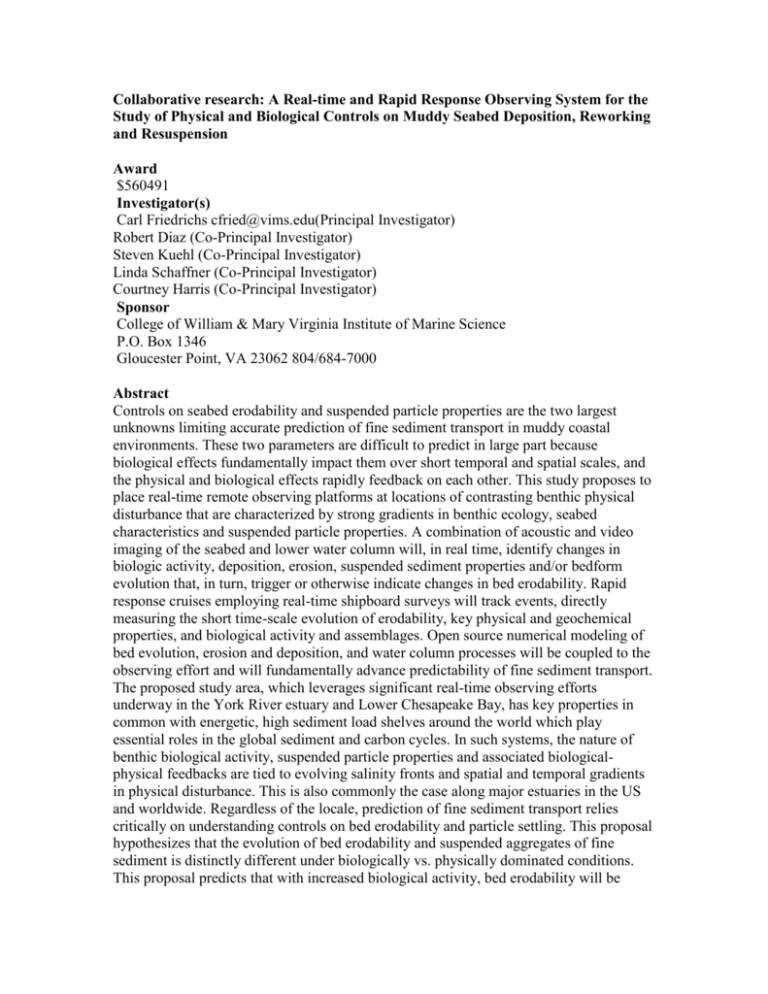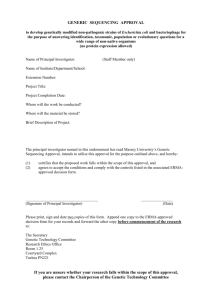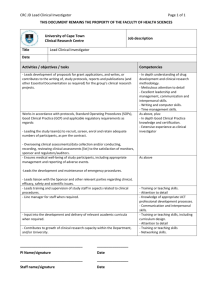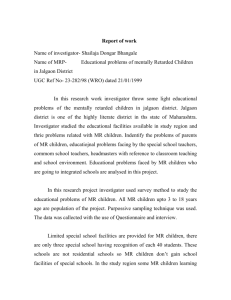U - Biology Department
advertisement

Collaborative research: A Real-time and Rapid Response Observing System for the Study of Physical and Biological Controls on Muddy Seabed Deposition, Reworking and Resuspension Award $560491 Investigator(s) Carl Friedrichs cfried@vims.edu(Principal Investigator) Robert Diaz (Co-Principal Investigator) Steven Kuehl (Co-Principal Investigator) Linda Schaffner (Co-Principal Investigator) Courtney Harris (Co-Principal Investigator) Sponsor College of William & Mary Virginia Institute of Marine Science P.O. Box 1346 Gloucester Point, VA 23062 804/684-7000 Abstract Controls on seabed erodability and suspended particle properties are the two largest unknowns limiting accurate prediction of fine sediment transport in muddy coastal environments. These two parameters are difficult to predict in large part because biological effects fundamentally impact them over short temporal and spatial scales, and the physical and biological effects rapidly feedback on each other. This study proposes to place real-time remote observing platforms at locations of contrasting benthic physical disturbance that are characterized by strong gradients in benthic ecology, seabed characteristics and suspended particle properties. A combination of acoustic and video imaging of the seabed and lower water column will, in real time, identify changes in biologic activity, deposition, erosion, suspended sediment properties and/or bedform evolution that, in turn, trigger or otherwise indicate changes in bed erodability. Rapid response cruises employing real-time shipboard surveys will track events, directly measuring the short time-scale evolution of erodability, key physical and geochemical properties, and biological activity and assemblages. Open source numerical modeling of bed evolution, erosion and deposition, and water column processes will be coupled to the observing effort and will fundamentally advance predictability of fine sediment transport. The proposed study area, which leverages significant real-time observing efforts underway in the York River estuary and Lower Chesapeake Bay, has key properties in common with energetic, high sediment load shelves around the world which play essential roles in the global sediment and carbon cycles. In such systems, the nature of benthic biological activity, suspended particle properties and associated biologicalphysical feedbacks are tied to evolving salinity fronts and spatial and temporal gradients in physical disturbance. This is also commonly the case along major estuaries in the US and worldwide. Regardless of the locale, prediction of fine sediment transport relies critically on understanding controls on bed erodability and particle settling. This proposal hypothesizes that the evolution of bed erodability and suspended aggregates of fine sediment is distinctly different under biologically vs. physically dominated conditions. This proposal predicts that with increased biological activity, bed erodability will be greater and decrease less strongly with depth, but suspended aggregates will be larger and stronger due to small-scale biological binding. Under physically dominated conditions, erodability will increase suddenly with deposition, but decrease more quickly with time and depth due to rapid consolidation. Under physical dominance, suspended aggregates/flocs will be smaller and weaker, have smaller fall velocities, and decrease in size with increased stress due to breakup by shear. Genomic Approaches to Advance the Species Definition for Prokaryotes Award $117345 Investigator(s) James Tiedje tiedjej@pilot.msu.edu(Principal Investigator) Konstantinos Konstantinidis (Co-Principal Investigator) Sponsor Michigan State University East Lansing, MI 48824 517/355-1855 Abstract The total biomass of the smallest organisms on Earth, the bacteria and the archaea, is estimated to equal or exceed that of all terrestrial and marine plants, and is the largest reservoir of unexplored biodiversity. Despite the global importance of microbes, several aspects of their biology remain poorly understood, including what delimits bacterial species. Increasingly, the scientific community is finding the current species definition for bacteria to be lacking. This has broader impacts with regard to reliable diagnosis of infectious disease agents, intellectual property rights, international and national regulations for transport and possession of pathogens, biodefense oversight, reporting, and quarantine. For instance, the highly pathogenic strains of Escherichia coli O157:H7, which causes severe enterohaemorrhagic infections in humans, are grouped together in the same species with the innocuous laboratory strain K12. If species designations are not well founded or phenotype not well circumscribed by the "species", inefficiencies occur and in some cases could result in serious harm. New regulatory processes have noticeably constrained microbiological research, including the international exchange of strains and type material, a situation that could be aided by a more accurate definition for bacterial species. The objective of this project is to use whole-genome sequence typing and gene content and expression patterns of bacteria to understand the genetic differences among closely related strains. The goal is to determine if there are underlying patterns in gene content that can be used to define coherent clusters of strains, and hence biological evidence for a natural species boundary for bacteria. Comparative analyses on several families of bacterial genomes will reveal if there are evolutionary differences among the families that reflect their ecological niches. Finally, these molecular analyses may lead to better tools to define and identify species. The research effort will also involve training opportunities for undergraduate students and a postdoctoral scientist. Carbohydrate Based Self Assembling Systems Award $228000 Investigator(s) Guijun Wang gwang2@uno.edu(Principal Investigator) Sponsor University of New Orleans Lake Front New Orleans, LA 70148 504/280-7154 Abstract The main focus of this research project is to create novel functional biocompatible materials from abundant carbohydrates that could lead to advancements in carbohydrate chemistry, materials science, biotechnology, and the biomedical field. This program will allow the discovery of novel materials with desired functionality based on renewable resources. Professor Wang's research will increase the availability of small molecule hydrogelators and allow others to explore their applications. The immobilization of enzymes using the hydrogelators obtained is important for biocatalysis, high throughput assays, and drug discovery. Diacetylene-containing hydrogelators can form stimuliresponsive smart gels that can be used as sensors for pH, temperature, and for sensing the presences of biomolecules and toxins. The new materials discovered will have biomedical applications as controlled release media, tissue-engineering scaffolds, and also for protein immobilization and purification. This will advance understanding of the correlation of molecular structures and macroscopic properties and help to guide other researchers in designing intelligent materials. The Organic and Macromolecular Chemistry Program supports Professor Guijun Wang of the University of New Orleans whose research involves several interdisciplinary research areas including organic synthesis, supramolecular chemistry, bioorganic chemistry and materials science. The broader impacts of the proposed work in addition to the potential biomedical applications are the training of students at all levels and the incorporation of this research into education. The training of students in these multidisciplinary areas will prepare them for future careers in biomaterials research, organic synthesis, and biomedical fields. Special efforts will be made to recruit undergraduate students, especially minorities, to conduct research, which can help to improve retention and stimulate interest in science fields. A website will be developed containing related scientific discoveries, background information, and career guidance for students. A planned future special topics course resulting from the current research and planned international collaborations will further increase the impact of this research program. Mechanisms and Integration of Signal Pathways: A Role for Calpains? Expected Total Amt. $300000 (Estimated) Investigator Dorothy E. Croall (Principal Investigator current) Sponsor University of Maine 5717 Corbett Hall Orono, ME 044695717 207/581-1110 Abstract Cells receive environmental signals which determine their development, growth and differentiation. How external signals transmit information to the nucleus to regulate these processes is a fundamental question of cell biology. The long range goal of this research is to understand the biochemical mechanisms that mediate cellular responses to these signals. This project focuses on the two calcium-dependent proteolytic enzymes, microand milli- calpain (EC 3.4.22.17), and a protein inhibitor that specifically inhibits them, calpastatin. These enzymes may play a direct role in calcium-linked signal pathways and also may mediate integration (cross-talk) between signalling pathways. The proteins susceptible to calpain represent each phase of signal transduction including receptors, kinases, phosphatases and transcription factors. It is not known whether these signalling components share common features that are recognized by calpain. These studies will characterize the substrate recognition determinants for calpains by 1) identifying the calpastatin binding site within calpain; 2) testing the hypothesis that either calmodulinbinding domains, PEST- regions, or both, mediate substrate recognition; and 3) analyzing the amino acid sequences surrounding calpain-cleavage sites within potentially, physiologically significant protein targets. Results of these studies will provide new approaches for experimental manipulation of calcium-linked signal pathways. Another objective is to discover how calcium regulates calpain activity. It is hypothesized that the regulation of calpain by calcium is analogous to calmodulin regulation of its target enzymes. A first step toward testing this hypothesis will be to examine the effects of calmodulin antagonists on calpain. Further tests of the hypothesis are envisioned, but are beyond the scope of this project. The results of these experiments should provide important insights towards a general understanding of how calcium regulates the functions of the proteins and enzymes that can bind calcium ion directly. %%% Cells receive environmental signals which determine their development, growth and differentiation. How external signals transmit information to the cell nucleus to regulate these processes is a fundamental question of cell biology. One major internal messenger in signaling is calcium. Intracellular calcium levels have been found to go up in response to a variety of signals in many types of cells, but the mechanisms by which calcium acts in various signaling pathways are not yet understood despite much research. This project focuses on two calcium-dependent enzymes that break down specific proteins, and an inhibitor that specifically inhibits them. These enzymes may play direct roles in calcium-linked signal pathways and also may mediate cross-talk between different signalling pathways. A primary goal of this research is to characterize the mechanisms by which the calcium- dependent enzymes recognize and act on other proteins in the signaling pathways. The results will be an important contribution to our understanding of the role of calcium in cellular signal transduction mechanisms.*** Molecular Analysis of Meiotic Recombination in the Bronze Genomic Region of Maize Award $204716 Investigator(s) Hugo Dooner dooner@waksman.rutgers.edu(Principal Investigator) Sponsor Rutgers University New Brunswick ASB III, 3 Rutgers Plaza New Brunswick, NJ 08901 732/932-0150 Abstract Homologous meiotic recombination is an important process because it creates new genotypes by shuffling chromosomal segments that otherwise would be inherited as blocks and promotes fertility by ensuring that chromosomes segregate properly. Recombination allows the construction of genetic maps, which are used in risk prediction for inherited disorders, in marker-assisted selection of desirable genotypes in agriculture, and in map-based cloning of valuable genes in plants. This project will increase our understanding of homologous meiotic recombination in maize, which is an excellent model organism for studies of recombination and has economic importance to American agriculture and industry. Much of the work is based on the discovery in the PI's lab of an unprecedented level of haplotype variability in maize. The project aims to study how recombination is affected by it. The project will continue to analyze meiotic recombination in maize by combining the power of the genetics of the bz region with that of modern molecular tools. The project is relevant to U.S. agriculture in that it studies meiotic recombination, the phenomenon underlying most plant breeding. The project will be staffed by members of under-represented minorities and will serve as excellent training ground for undergraduate students interested in learning modern genotyping techniques. The P.I. himself is actively involved in collaborations with scientists from developing countries.








